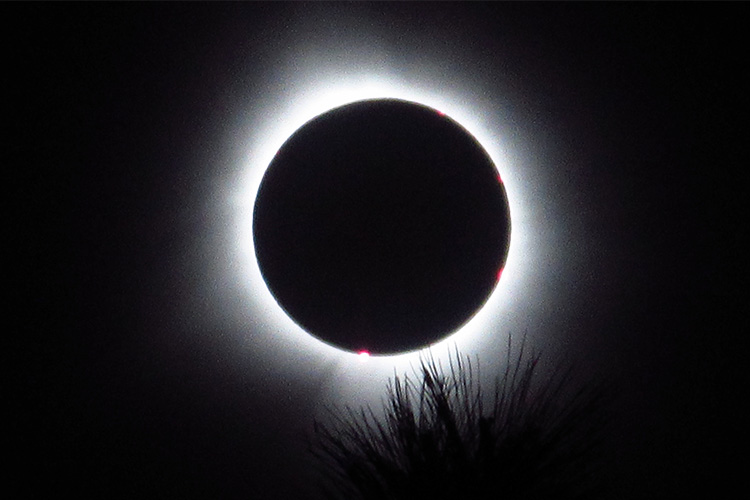
On Monday, April 8, millions of people across North America witnessed an incredible astrological event. photo by Drea Stein
The next total solar eclipse to pass through the US won’t occur until 2044.
In August of 2017, I traveled to Illinois to see the total solar eclipse. I was amazed, and, like many, made hypothetical plans to see the next eclipse to pass through the U.S.. Luckily for me, the path of totality of the next eclipse happened to pass through the exact same place I had watched the 2017 eclipse from: my dad’s summer camp. On average, a total solar eclipse passing over the same spot twice happens only every 366 years, according to NASA. In April of this year, I went back to Illinois to see if I could recapture some of the magic I had experienced in 2017. In my opinion, the eclipse this year was even better than the one seven years ago (though how much of that is recency bias, I can’t say).
What is a solar eclipse? There are several types, but they all happen when the moon’s shadow blocks the sunlight from a portion of the Earth. During an annular or partial solar eclipse, the moon passes between the sun and Earth, but isn’t at the exact spot in its orbit to completely cover the Sun. These eclipses typically happen several times a year, the last one being on October 14, 2023. Total solar eclipses, however, are different. They happen when the moon, sun, and Earth are all perfectly aligned to allow the moon to completely block the sun’s light from a section of the Earth, called the path of totality. In contrast to partial or annular eclipses, viewers can remove their protective eclipse glasses and look directly at the sun (or, really, the moon). Additionally, total eclipses, especially those that pass over large portions of land, instead of just over the ocean, are more rare. The most recent total solar eclipse took place on April 8th, 2024, and the path of totality stretched from Mexico, across much of the US, and into parts of Canada. Totality—where the moon completely covers the sun and people can take off their eclipse glasses—lasted for around four minutes.
In the weeks leading up to April 8th, I had been obsessively checking the weather forecast, hoping that my viewing experience wouldn’t be ruined by clouds. Many eclipse watchers traveled to Texas, which has a higher chance of having sunny skies this time of year, but southern Illinois, where I was hoping to view the eclipse, is often rainy. The day before the eclipse, in fact, was very rainy, but Monday dawned with mostly clear skies and only a few scattered cirrus clouds. Around 100 people from Missouri, Tennessee, and other states had come to our property to rent cabins for the eclipse weekend, and around 100 more people who lived nearby arrived on eclipse day itself. This assembly included a wedding that was set to happen during maximum totality, and a group of students from Fisk University in Nashville, Tennessee who received a grant from NASA to study how the eclipse affects atmospheric pressure, temperature, and more as part of a challenge with many other schools across the nation. They launched a balloon that carried several payloads (boxes attached to from the balloon) that contained a GPS and would collect their data. In October, the students had traveled to Texas to study the partial eclipse with the balloon, and it reached 96,000 feet, allowing them to see the curvature of the Earth. Though they experienced some complications and technical difficulties when launching the balloon during the total eclipse, the students managed to have an overall successful launch, with the balloon reaching around 99,000 feet and flying for around three hours before landing in Indiana. “This has been a very impactful project for us… we’re the only liberal arts HBCU school that’s doing this,” explained Indigo Jones, a Computer Science major from Fisk. “We’re planning to put the footage in a VR [virtual reality] headset and use that for outreach purposes so kids could experience the eclipse as a way to get them interested in STEM.”
During the eclipse, my dad and I took out a canoe on the lake that borders our camp. Most people had chosen to watch the eclipse on the baseball field, so the lake was relatively quiet. In the hours leading up to totality, the sky gradually got darker, but as totality approached, the sunlight faded quicker, and we could see a sunset emerge from everywhere around the horizon. A variety of things about the eclipse stand out to different people, from being able to see stars and planets in the middle of the day to hearing crickets and other animals begin their night time routines. For me, one of the most striking things was how the wind stopped, something that was especially evident in a boat on the lake. I can’t explain what totality felt like—I really believe you had to be there to understand—but, as Jenn Becker, another viewer I talked to, described, “There’s so many big things that fill my head all the time and for 4 minutes… it all went away.” During the brief minutes of totality, I felt like nothing actually mattered (in a good way). In the face of an epic cosmic coincidence (since that’s honestly what a total eclipse is), my small human struggles are pointless, yet they are also the most important thing in the world. Nothing matters, therefore everything matters. The next eclipse to pass through the U.S. won’t happen for another 20 years, but I’ll be sure to be there.